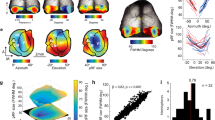Summary
Cats reared with their visual world restricted to vertical lines for one eye and horizontal lines for the other had, in their visual cortices, units with elongated receptive fields that were either vertically or horizontally oriented. These receptive fields could be mapped only using that eye which had seen lines of the same orientation during development. Other units had diffuse, unresponsive receptive fields (Hirsch and Spinelli, 1970). Six cats, from the group above, were revived and allowed normal binocular viewing in an attempt to determine the possibility and extent of adding other types of receptive fields by giving other experiences to their visual systems. After exposure to a normal environment for up to 19 months it was found that indeed there had been a massive increase in the percentage of those classes of receptive fields that were either absent or weak at the end of the selective visual experience. Significantly, these receptive fields, acquired during binocular viewing, were very often binocular.
The results, however, show that units whose response characteristics mimic the stimuli viewed during development were almost completely unaffected by normal binocular visual experience, i. e., they were monocularly activated and had the orientation appropriate for the stimuli viewed by the eye from which they could be mapped. Most impressive are a few units whose receptive field shape is almost a carbon copy of the pattern viewed during development. The data provide evidence that visual experience has a direct continuing and lasting effect on the functional connectivity of cells in the visual cortex.
Similar content being viewed by others
References
Blakemore, C., Cooper, G.F.: Development of the brain depends on the visual environment. Nature (Lond.) 228, 447–478 (1970).
Chow, K.L., Stewart, D.L.: Reversal of structural and functional effects of long term visual deprivation in cats. Exp. Neurol. (in press).
Ganz, L., Fitch, M., Satterberg, J.A.: The selective effect of visual deprivation on receptive field shape determined neurophysiologically. Exp. Neurol. 22, 614–637 (1968).
Hirsch, H.V.B.: The modification of receptive field orientation and visual discrimination by selective exposure during development, Ph. D. Thesis, Stenford University (1970).
— Spinelli, D.N.: Distribution of receptive field orientation: modification contingent on conditions of visual experience. Science 168, 869–871 (1970).
—: Modification of the distribution of receptive field orientation in cats by selective visual exposure during development. Exp. Brain Res. 13, 509–527 (1971).
Hubel, D.H., Wiesel, T.N.: Receptive fields and functional architecture in two non-striate visual areas (18 and 19) of the cat. J. Neurophysiol. 28, 229–289 (1965).
—: The period of susceptibility to the physiological effects of unilateral eye closure in kittens. J. Physiol. (Lond.) 206, 419–436 (1970).
Morest, D.K.: The growth of dendrites in the mammalian brain. Z. Anat. Entwickl.-Gesch. 128, 290–317 (1969).
Otsuka, R., Hassler, R.: Über Aufbau und Gliederung der corticalen Sehsphäre bei der Katze. Arch. Psychiat. Nervenkr. 203, 212–234 (1962).
Shlaer, R.: Shift in binocular disparity causes compensatory change in the cortical structure of kittens. Science 173, 638–641 (1971).
Spinelli, D.N.: Visual receptive fields in the cat's retina: complications. Science 152, 1768–1769 (1966).
—: Receptive field organization of ganglion cells in the cat's retina. Exp. Neurol. 19, 291–315 (1967).
—: Recognition of visual patterns. Proceedings for Research in Nervous and Mental Disease 48, 139–149 (1968).
—: Occam: a computer model for a content addressable memory in the central nervous system. In: Biology of Memory, pp. 293–306. Ed. by K.H. Pribram and D.E. Broadbent. New York: Academic Press 1970.
— Barrett, T.W.: Visual receptive field organization of single units in the cat's visual cortex. Exp. Neurol. 24, 76–98 (1969).
— Bridgeman, B., Owens, S.: Technical note: a simple single-unit microelectrode recording system. Med. biol. Engng. 8, 599–602 (1970).
— Hirsch, H.V.B.: Genesis of receptive field shapes in single units of oat's visual cortex. Fed. Proc. 30, 615 (1971).
— Pribram, K.H., Bridgeman, B.: Visual receptive field organization of single units in the visual cortex of monkeys. Intern. J. Neuroscience 1, 67–74 (1970).
Valverde, F.: Rate and extent of recovery from dark rearing in the visual cortex of the mouse. Brain Res. 33, 1–11 (1971).
Author information
Authors and Affiliations
Rights and permissions
About this article
Cite this article
Spinelli, D.N., Hirsch, H.V.B., Phelps, R.W. et al. Visual experience as a determinant of the response characteristics of cortical receptive fields in cats. Exp Brain Res 15, 289–304 (1972). https://doi.org/10.1007/BF00235913
Received:
Issue Date:
DOI: https://doi.org/10.1007/BF00235913




